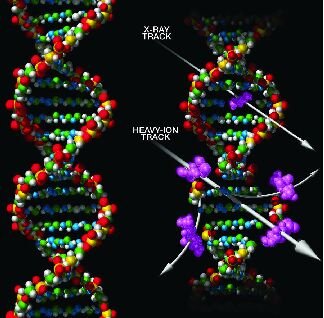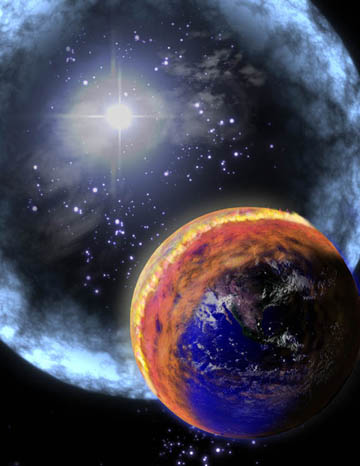Cosmic Rays Zap a Planet's Chances for Life

Mysterious cosmic rays constantly bombard Earth from outer space. Now scientists find these energetic particles could limit where life as we know it might exist on alien planets.
Cosmic rays continue to baffle scientists more than a century after they were first discovered. These charged subatomic particles zip through space at nearly the speed of light, a few strangely with energies up to 100 million times beyond what is possible from the most powerful particle accelerator on Earth. Cosmic rays are believed to be atomic nuclei, with the vast majority being protons, or hydrogen nuclei.
When cosmic rays hit Earth's atmosphere, they generate a shower of other particles, including muons, which are essentially much heavier versions of their cousin the electron. Some of these particles reach Earth's surface, potentially damaging life on land and in the oceans — muons can even penetrate hundreds of feet below a planet's surface. [8 Baffling Mysteries of Astronomy]
Scientists investigated how cosmic rays might influence the habitability of distant alien worlds. The hundreds of exoplanets astronomers have discovered in the past two decades using ground and space telescopes have raised the possibility that some might be home to extraterrestrial life. Interest is especially focused on worlds in so-called habitable or Goldilocks zones, which receive enough heat to possess surfaces that can keep water liquid rather than freeze — on Earth, there is life virtually wherever there is liquid water.
The investigators reasoned the level of radiation a planet receives helps control its habitability. While a planet might see much fewer galactic cosmic rays compared to the radiation from its star, the average energy of cosmic rays is far higher than photons and protons from the star, making them critical to focus on.
"If the radiation dose is too high, then life as we know it cannot exist," said study author Dimitra Atri, a physicist at the Blue Marble Space Institute of Science, a nonprofit institute with a network of scientists across the world.
The researchers concentrated on two factors that might influence the cosmic ray dose a planet gets — the strength of its magnetic field, and the depth of its atmosphere.
Breaking space news, the latest updates on rocket launches, skywatching events and more!
"I started thinking about this problem when I was thinking about Mars and Earth, which are next-door neighbors, and how we have a thriving biosphere here on Earth, while it's safe to say Mars does not have a thriving biosphere on its surface. Why is that so?" Atri said. "The main factor is that Mars has a high level of radiation — the atmosphere on Mars is almost negligible, very, very small compared to Earth's, and it has no planetary magnetic field, so it has no shielding from the cosmic rays found everywhere in the galaxy. So I wondered what intermediate scenarios might be like, lying between these two extremes." [The Search for Life on Mars (A Photo Timeline)]
The investigators simulated planets ranging from ones with no magnetic field to ones as strong as Earth's, and worlds with atmospheres ranging from as thick as Earth's to just a tenth as thick.
"We know the magnetic field around Earth protects us from these harmful cosmic rays, and we thought magnetic fields were going to be the main factor that controls the radiation dose to the surface," Atri said.
Unexpectedly, "we found the thickness of a planet's atmosphere is a much more important factor in determining a planet's radiation dose," Atri told Astrobiology Magazine. "If you took the Earth and you completely removed the magnetic field, the radiation dose rate will increase by two, which is a big increase, but it would still have very small effects, and would not have any effects on us. However, if you keep the magnetic field and decreased the atmosphere so it is a tenth as thick, the radiation dose will increase by more than two orders of magnitude."
Planets around red dwarf stars are often thought of as prime targets for the search of alien life, since these relatively dim stars are very common in the universe, making up at least 80 percent of the total number of stars. Theoretical calculations suggested planets in the habitable zones close to red dwarfs are more likely to have weaker magnetic fields, especially in the case of so-called super-Earths, large rocky planets up to 10 times Earth's mass. Astrobiologists were concerned these weak magnetic fields could make them poor candidates for life, but these new findings suggest weak magnetic fields are less of a problem than they thought.
Future research can examine how increasing radiation affects the evolution of life, Atri said. "Most studies of radiation's effects on life mostly expose organisms to very high doses of radiation to see if they get killed or not, but I think systematic studies that gradually increase the radiation microbes receive could show how they evolve in environments that receive a lot of cosmic rays," he said.
Atri and his colleagues B. Hariharan and Jean-Mathias Griessmeier detailed their findings in the October issue of the journal Astrobiology.
This story was provided by Astrobiology Magazine, a web-based publication sponsored by the NASA astrobiology program. Follow us @Spacedotcom, Facebook and Google+.

Charles Q. Choi is a contributing writer for Space.com and Live Science. He covers all things human origins and astronomy as well as physics, animals and general science topics. Charles has a Master of Arts degree from the University of Missouri-Columbia, School of Journalism and a Bachelor of Arts degree from the University of South Florida. Charles has visited every continent on Earth, drinking rancid yak butter tea in Lhasa, snorkeling with sea lions in the Galapagos and even climbing an iceberg in Antarctica. Visit him at http://www.sciwriter.us




